Celebrating Movement
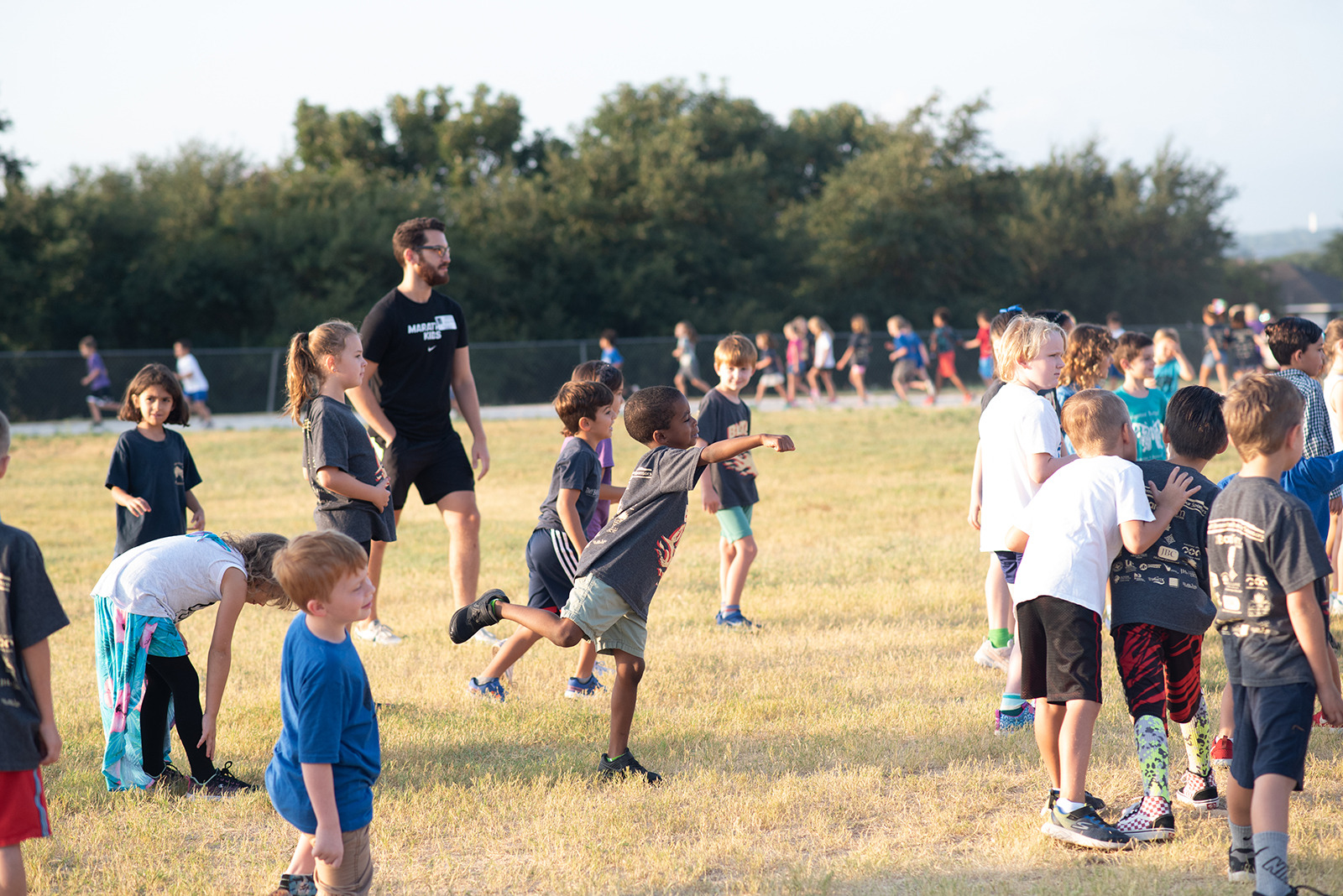
It’s a steamy mid-September morning in southwest Austin. The sun rises over the trees near the outdoor track at Baranoff Elementary School as grinning first-graders kick up dust with their heels, running the eighth-mile loop together. Their shadows stretch long in the golden light, a hint that no matter how small in stature they might be today, they will grow tall. Their lives stretch out before them, filled with possibility.
It is Friday, September 13, and it is Marathon Kids Day by official proclamation by Austin Mayor Steve Adler. The children run this morning in honor of this special day, but they would be running regardless — they are Marathon Kids. They run every day at school as part of this national program that began in Austin in 1995.
Most of the children wear tee-shirts and shorts, but plenty run in dresses or pants. There are even a few tutus in the crowd. Some hold hands with friends as they run. A few fall down and quickly pick themselves up again, teaching themselves resilience with every lap they run. Every child on the track looks determined, joyful and relaxed as they pump their legs and keep moving forward.
Teachers and administrators line the track, clapping and calling out encouragement as the children run through a makeshift finishers’ tent, complete with colorful streamers fluttering in the slight breeze, and burst out the other side to complete another loop. After a lap or two or three, some of the kids begin to slow down and start walking. Some stop for a high-five from a teacher or counselor. Some boast, “I ran eighty-seven laps!” Others claim they did even better: “I ran a hundred!”
It’s a natural thing for children to compete with themselves and their friends, but the teachers emphasize working together. “Great job!” one exclaims as her students begin to line up to return to class. “I saw some really good teamwork out there!”
Marathon Kids run clubs are in schools around the country, including 81 elementary schools across Austin Independent School District. The organization’s mission is simple: to get kids moving, instill in them a love of running and set them on the path toward a healthy lifestyle for the rest of their lives. This year, Marathon Kids Day is about celebrating the 30,000 students across the district who are participating in run clubs this school year, and the 500 teachers, administrators, counselors, nurses and other school staff members who prioritize movement during the school day.
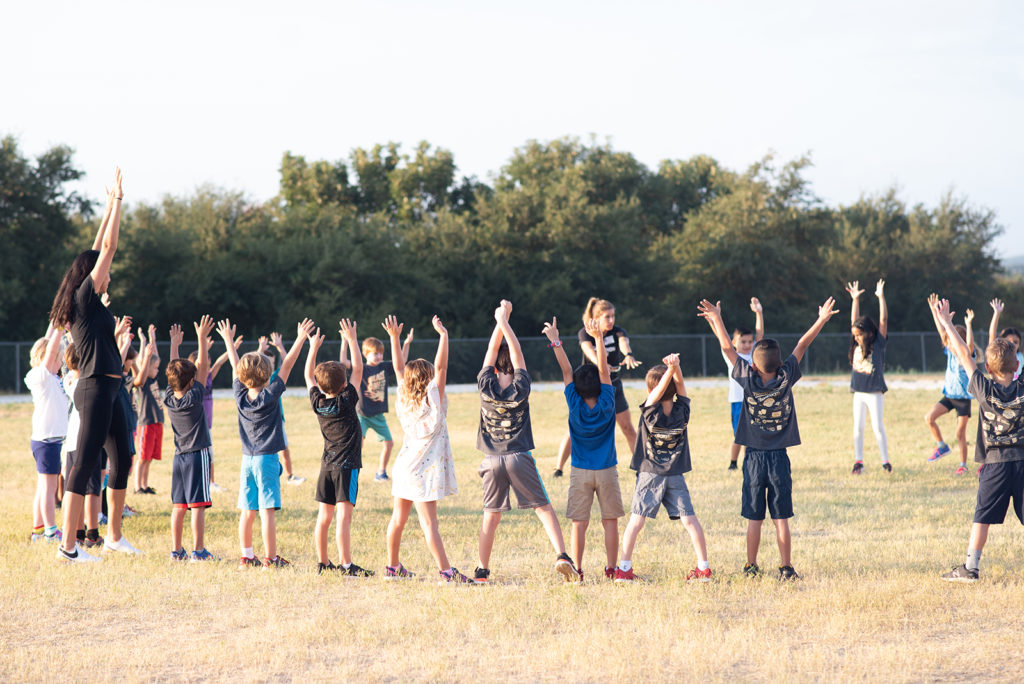
“Research shows that kids need brain breaks,” says Baranoff Principal Beth Cantu, “and exercise helps with learning and stamina throughout the day. That’s one of the benefits of Marathon Kids.”
Baranoff P.E. teacher and Marathon Kids coach Kelli Page points out that the recommended minimum of moderate to vigorous exercise for children is 60 minutes per day, but many kids don’t have time to be active after school, especially as the seasons change and the sun begins setting earlier.
“Our physical education and wellness classes don’t meet the standard minutes,” Page says, “so we need the WOW time to make up for that.”
WOW stands for Working Out for Wellness, an initiative that helps Austin students meet district requirements for daily physical activity outside of P.E. class. At Baranoff, 10 minutes of WOW time per day is dedicated specifically to Marathon Kids. Some students can run a full mile or more during that window.
“One of the main reasons we implemented Marathon Kids schoolwide was to tie it into our WOW program,” Page says. “It ties into cardiovascular fitness, which is part of coordinated school health, and it’s a structured activity for the students so they can actually see progress from the start of the year. How many laps can I do today versus how many can I do at the end of the year?”
Page also points out that Marathon Kids gives children opportunities to set goals.
“[With Marathon Kids], when you make an accomplishment, you get a reward, so you’re motivated to keep going. It’s also something that we as teachers can model for kids, since we’re also active,” Page says. “We keep our own logs out in the hall by the doors, so kids can see what mile we’re on. They can see what we’re doing and see that it’s important for them to stay active and healthy as part of that 60 minutes a day of getting out and moving your body.”
I have two children in elementary school in Austin ISD, yet I wasn’t aware my daughter was participating in Marathon Kids until she brought home a tee-shirt in first grade, her reward for reaching her first milestone — logging a cumulative marathon, or 26.2 miles. My daughter is an active kid. She also has Down syndrome, which means her joints are a bit loose; endurance and speed aren’t yet strong points for her. The Marathon Kids’ focus on cumulative mileage, logged at one’s own pace over time, is perfect for her.
In fact, it’s perfect for children of all fitness levels and abilities. As Coach Page points out, anyone can participate in Marathon Kids, including children with limited mobility.
“It doesn’t matter your age. You don’t need equipment — you just need to find a space to move your body,” she says.
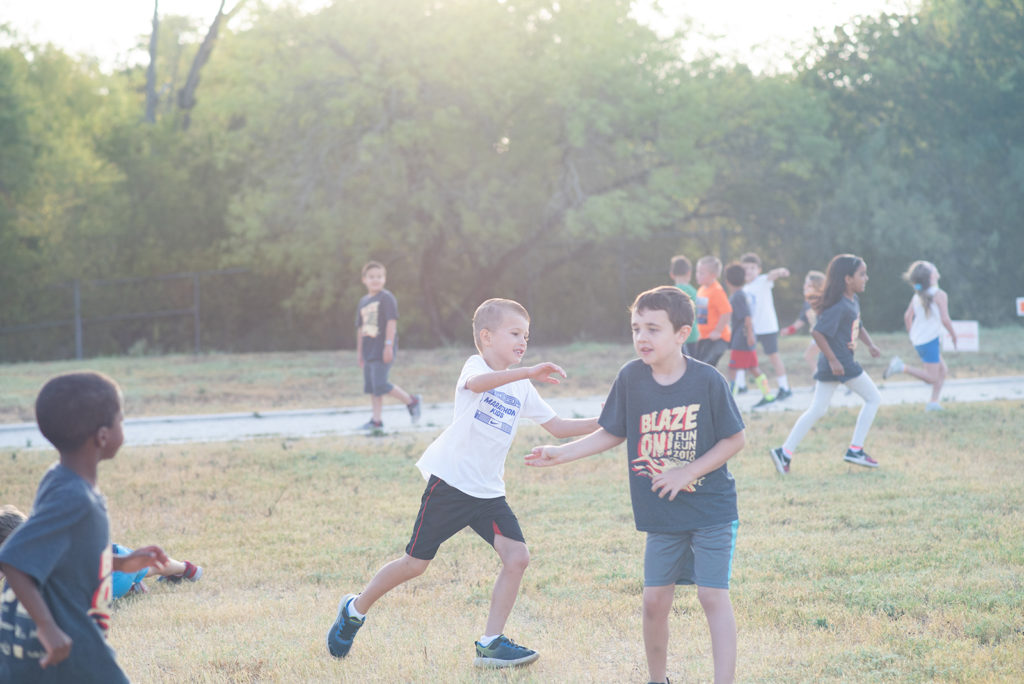
Students can run, walk, skip or dance to achieve their milestones. They can use walkers or wheelchairs and go at any pace.
This year, my daughter is in second grade and my son is in first. He loves running, frequently claiming he’s fast like The Flash. After watching his big sister bring home swag like laces and shoe tags last year, he was excited to start running with Marathon Kids this fall, too. I’m glad my children are being exposed to something so positive that is setting a firm foundation in the importance of physical activity — and the fun of it. It is a human, joyful thing to move your body. The gleeful smiles on the children’s faces at Baranoff as they run around the track speak to that.
But as modern lifestyles become more sedentary, it becomes tougher to make time for exercise and motivate ourselves to do it. Unfortunately, it is all too easy to get out of the habit of moving and lose touch with the joy that comes with physical activity.
“Some children don’t necessarily get the message at home about lifelong fitness,” says Vincent Brouillard, Coach Page’s co-teacher at Baranoff. “They get that message through us and seeing older students participate in the program. They look forward to it, and the little guys get really excited. They just enjoy being out here moving, just sharing the joy of exercise, and we enjoy showing them adults who try to stay fit and being role models for that.”
Marathon Kids CEO Cami Hawkins is present at Baranoff the morning of Marathon Kids Day, cheering the runners on and helping them celebrate.
“Marathon Kids is important,” Hawkins says, “because kids aren’t getting the physical activity that they need. Unfortunately, research shows that this is the first generation that will have a shorter life expectancy than their parents. To think that these kids are not going to be able to live as long because of the way that our lifestyles are now — it’s really unreal.”
Research shows only one in five children get the recommended minimum amount of physical activity per day.
“We really are kind of pushing a boulder up a hill,” Hawkins says. “As far as trying to get these kids reengaged with physical activity. But when you look around and see how happy they are, the joy — they’ve been out here running for 30 minutes now, in the heat, but they love it. And when they go inside to learn, their brains are going to be on fire.”
Hawkins feels Austin is lucky to have Marathon Kids incorporated into the school day, thanks to Michele Rusnak, the district P.E. coordinator, who adopted the program as the WOW curriculum almost five years ago.
“The district prioritizes physical activity in school,” Hawkins says, “which is really awesome for Austin, and for our kiddos.”
In Austin, only elementary schools participate, but Marathon Kids run clubs are in schools across the nation, including middle and high schools.
“There are a few high schools that use the Marathon Kids mileage logs, content and research,” Hawkins says, “to motivate their cross-country runners and teach them how to track and keep mileage plans. The mileage might change with the ages, but the basic plan is the same for everyone.”
Austin is known to be a fit city, and with Marathon Kids being district-wide, “we do see that the statistics in Austin are better than the national average,” Hawkins says, “which you would expect. At schools like Baranoff, the coaches have really adopted Marathon Kids as a culture. In Austin, we’re focused on the whole child, and Marathon Kids hits every single one of those tenets.”
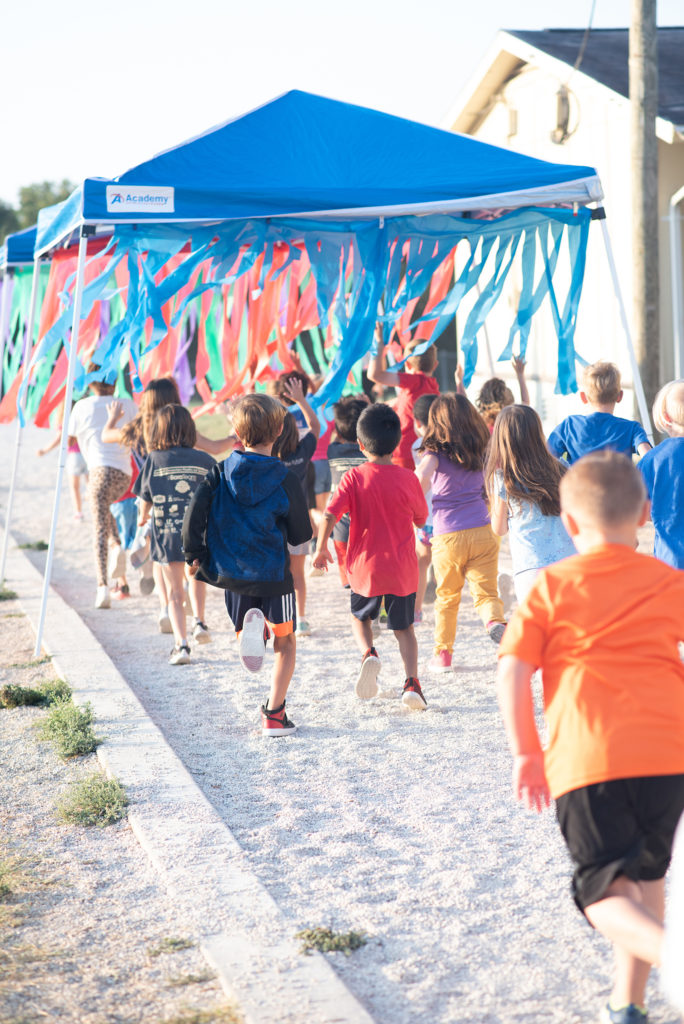
She points to the CASEL Core Competencies, which emphasize social and emotional learning — the human process of managing our emotions, setting positive goals and achieving them, treating others with empathy and making responsible decisions.
Marathon Kids, Hawkins says, teaches children “to be empathetic, to know how to have a conversation about supporting one another, to be able to talk about the challenges that they’re facing. To be able to set goals together and achieve those goals little steps at a time — it’s amazing.”
Baranoff counselor Jane Tackett agrees.
“I’m a big fan of getting out and exercising, and I am always encouraging the kids to do the same, because exercise kicks in those endorphins, and it can make them not just physically healthy but also mentally healthy. That’s key to a successful life as well as to success in academics and sports.”
As the school counselor, Tackett sees even the youngest students dealing with heavy issues, and she sees the benefits of exercise in helping them manage their feelings and their bodies.
“The biggest thing for children is to understand how to control themselves,” Tackett says, “and exercise definitely helps.”
Despite the positive impact that Marathon Kids run clubs are having on children in schools across the district and country, many parents aren’t aware of the organization.
“We work through the school, through the P.E. teachers, but it’s hard to reach all the way to the parents,” Hawkins says.
This year, for the first time, Marathon Kids is offering digital lap tracking as part of the program. Teachers and run club coaches can download the free Marathon Kids app on their phones, and each student will receive an ID card they can scan at the end of each lap they run.
“It’s really a cool utility for the coaches,” says Hawkins, “They don’t have to tally miles and laps anymore; they can just scan and get the data. Marathon Kids will also get the data, so we can come in and help earlier if we learn that kids aren’t hitting their targets.”
Parents can also have access to their children’s data and can track their children’s miles and follow their achievements with them.
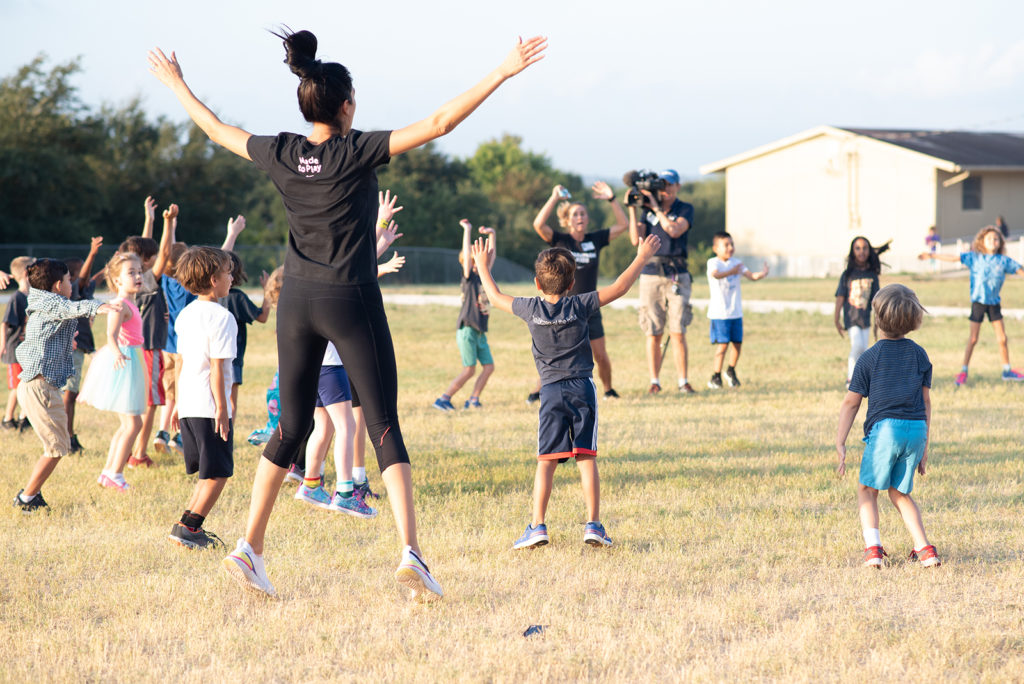
Spreading the word about Marathon Kids has been tough not just with parents, but with the broader community — even here in Austin, where the organization began. Run clubs are offered free-of-charge in schools, which means funding is an ongoing issue. In 2020, Marathon Kids will celebrate its 25th anniversary with TAG! Level Up, a festival-type event that promises to be a blast for all ages. Local businesses will have the opportunity to get involved through sponsorships to support this important program and help Marathon Kids find much-needed funding.
At Baranoff, one first-grade girl passes other runners as she races toward the finishers’ tent, her feet pounding the track and determination plain on her face. Her shadow runs silently alongside her as the sun illuminates her path into her own future. With Marathon Kids as a regular part of her day, helping her set healthy habits for a lifetime, her future promises to be that much brighter.
- Child Development
- Elementary Schools
- exercise
- health
- Kids
- Marathon Kids Day
- Marathons Kids
- movement
- wellness






